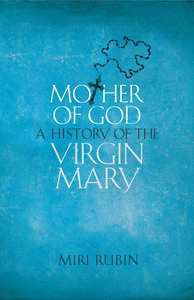

Take time for ...
... prayer
... an inspirational read
... spirituality
... seasonal meditation
... an inspirational read
Mother of God, A History of the Virgin Mary Miri Rubin, Allen Lane, 2009 |
 |
As the title, but not the front cover, suggests, this is an historical not a devotional work, dedicated to the question of how it is that Mary, about whom so little is said in the gospels, could become so imbued in culture as to be both familiar and iconic. So globally comprehensible a symbol is she that a singer launched her career in the 80’s simply by the name Madonna. Like that artist Mary herself has been through many re-inventions. Miri Rubin; Professor of Early Modern History at Queen Mary’s College, University of London, and a noted historian of Medieval Europe, guides us through the ideas and practices that have grown up around the Virgin Mary, with emphasis on the periods between early Christian times and the 1600’s. A scholarly and accessible book, it draws delightfully on music, poetry, art & theatre as well as miracle stories, theology & scripture. Hardly a page goes by without something for the senses, from the colour illustrations to the story of the acrobat-novice who praised Mary dancing on his hands while the other monks slumbered. When early Christians grappled with Christ’s divine and human nature they were inevitably drawn to Mary. Rubin begins here, exploring early understanding of the incarnation. In a defining moment at Ephesus Mary emerged as Theotokos, ‘Mother of God’; a unique woman of paradox, virgin yet pregnant, human yet able to bear God’s Son. As she was adopted by Emperors she advanced their cause and became more sophisticated and courtly. Images of her evolved from a simple figure with baby at the breast to a more sophisticated imperial woman, finely dressed. Themes of Mary’s own sinless conception, her life after Christ’s birth and even her death fuelled the rhetoric and song of the empire. Following her courtly appearances she soars majestically into the lives of monks against an upsurge of liturgy and chant. There she is companion, intercessor at time of death and wise leader. But, the monastery could not contain her and as Europe’s population and wealth exploded she became more familiar, taking on local colour and moving from Latin into the vernacular. This was an era of eloquent preaching akin to performance art, of lay confraternities where Mary’s tenderness abounded and of the creation of humble cribs to activate the imagination. Paradoxically as she drew nearer to ordinary life her importance became more elevated. Stronger, more powerful images emerged. She was one set apart, powerful mediator in conflicts, companion to kings and even to the Trinity. As Mary swooned in Pietàs and took prominence in the Rosary unease slipped in. Was Mary displacing Christ? Just as Mary is at the pinnacle of her visibility, reformation reinvented her again. For Protestants she was deglamorised, returned to the simplicity of the Scriptures, a model of modesty and humility, spawning a whole new splash of art refocused on Christ. For Catholics she was re-situated but ultimately remained a constant presence, personally consoling and at the same time immaculately close to God. In plotting Mary’s course through history her relationship with other religions and non-believers is a recurrent theme. For Muslims she was a respected lady of the Koran, in Egypt and much later in Mexico she blended with local goddesses, whereas for Jews she remained an anathema. Between Christians and Jews Mary symbolised conflict. As images and stories around Mary grew in anti-Jewish emphasis, conflict erupted into violence, culminating in the Thirteenth Century Trial of the Talmud and the expulsion of Jews from much of Europe. On route Rubin raises some interesting questions like, ‘when does an image of Mary stop being an image of Mary?’ * What differences are there in how men and women relate to her? On the former Rubin does nothing more than raise the question, on the latter she notes differences through the book. However, taking these issues further is left to the reader. Rubin has enough on her hands holding focus on the figure of Mary amidst complex social, political and religious interweaving. She succeeds, but in a serious way, only sometimes allowing humour, or her own stance to seep through, as in the final pages of the book. Here Mary appears for Rubin as mother. In her she sees the unspoken sense that all who bear a child are themselves god-like, “maker of life”. ** And so she adds her own voice to Mary’s ongoing re-invention. Avril O’Regan First Published in the Sunday Business Post, March 2009. * Page 421 ** Page 424 |